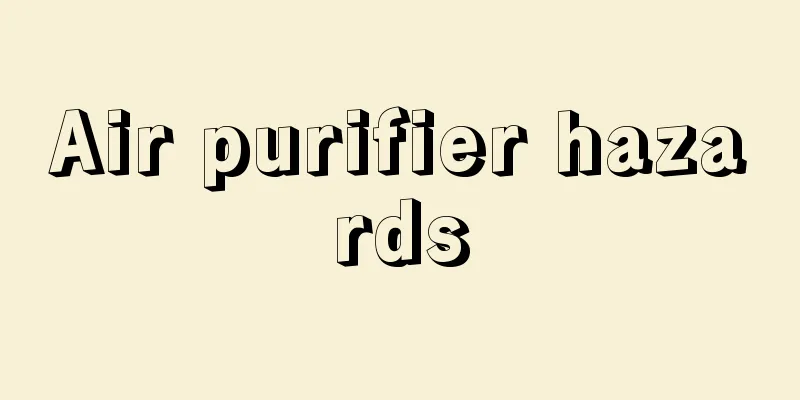Air purifier hazards

|
The increasing frequency of smog weather reflects that our living environment is getting worse and worse and the air quality is getting worse and worse than before. This has provided many businesses with business opportunities. The emergence of air purifiers has slightly improved our indoor air quality. However, air purifiers also have certain hazards. If used improperly, they may cause secondary pollution in the room. The following introduces the dangers of air purifiers, let’s take a look. What are the dangers of air purifiers? The harm of air purifiers is mainly due to secondary air pollution. If they are not used correctly and cleaned in time, air purifiers may cause secondary pollution of indoor air. 1. Secondary ozone pollution Some air purifiers produce ozone when working. People working and living in an environment with relatively high ozone levels are prone to cancer, and some ultraviolet rays can also produce ozone. 2. Secondary pollution of formaldehyde When the activated carbon reaches saturation after adsorbing formaldehyde, it will no longer release formaldehyde in your hands. Instead, as the temperature and wind speed increase, the formaldehyde adsorbed in the activated carbon will be released. This will cause secondary formaldehyde pollution, so the filter element needs to be replaced every once in a while. 3. Secondary pollution caused by fake and inferior products There are many counterfeit and shoddy products on the market, but they are poorly made, with internal mechanisms and components that do not meet the standards. Its purification ability is relatively poor and it is easy to cause secondary pollution to the indoor environment. How to avoid secondary pollution from air purifiers 1. Purchase qualified products When purchasing, you should look at the purification index of the air purifier. It is best to choose a more famous brand, at least the quality can be guaranteed. 2. Replace the filter regularly Secondary pollution is mainly caused by the long-term use of the filter, which accumulates a lot of bacteria and dust. When these accumulate in the air purifier, the purifier will become a source of pollution. The filter should be cleaned or replaced every half a month to a month. Misunderstandings about using air purifiers Myth 1: No matter how big the house is, one is enough This is wrong, because air purifiers, like air conditioners, need to match the area. General air purifiers can only purify 20 to 30 square meters. If the room is larger than 30 square meters, two air purifiers will be needed. Myth 2: Placing the air purifier against the wall The air purifier needs to be placed at a certain distance from the wall, and its placement will vary depending on the air outlet and inlet. Generally speaking, it is better to place the air purifier in a low place, or in the middle of the room. The effect will be better if the machine is placed lower, and a certain amount of space should be left around it to ensure air flow, which is conducive to improving air purification efficiency. Myth 3: Putting a humidifier next to the purifier Many people like to place a humidifier when using an air purifier to prevent the indoor environment from being too dry in winter. Turn both on at the same time. This is not a good idea. If you put a humidifier next to an air purifier, the indicator light on the purifier will sound an alarm and the air quality index will quickly increase. Putting the two together will interfere with each other. Because the water added to the humidifier is generally not purified water but tap water, which contains more minerals and impurities. The chlorine molecules and microorganisms in the water may be blown into the air from the humidifier to form a source of pollution. It is recommended that if you want to turn on the air purifier and humidifier at the same time, you need to keep a distance between them. Myth 4: The closer the air purifier is to people, the better When the air purifier is working, there will be more harmful gases around it. Users should not place the air purifier too close to people, and also keep it out of reach of children. Myth 5: Not changing the filter for a long time The air purifier needs to replace or clean the filter every half a month or once a month. If it is not replaced for a long time, continued use will not only have no purification effect, but will release harmful substances and become a "pollution source", thus leading to secondary pollution. Myth 6: Air purifiers are a smart way to deal with smog It is not only in smog that the air filter needs to be turned on. In many cases, indoor air pollution is more terrible than smog. If the room is not ventilated, there will be a lot of dust, bacteria, odors, etc., which will threaten people's health. Even if there is no haze, you can turn on the air purifier. It is also better to open the windows for ventilation when the air outside is good at noon. |
<<: What is the method to prevent porridge from overflowing?
>>: The hazards of hair conditioner
Recommend
Methods of treating colorectal cancer with traditional Chinese medicine
This disease belongs to the categories of "v...
What are the symptoms of lymphoma and what are the dietary treatments?
What are the symptoms of lymphoma? What is the di...
The main symptom of advanced cardiac cancer is worsening dysphagia
The symptoms of advanced cardiac cancer are mainl...
The efficacy of cattail sprout
As a traditional Chinese medicine, Goutou has str...
What foods can you eat regularly to improve your immunity?
Everyone knows that only when the human body has ...
What is the function of Guilinggao?
For people in the south, Guilinggao can be said t...
How to remove scars left by suture surgery
When undergoing certain surgical treatments, stit...
How many chemotherapy sessions are usually given for advanced lung cancer?
There is no indication for surgical treatment in ...
Treatment and care of bladder cancer
Bladder cancer treatment and care? Bladder cancer...
Which department should I go to for lymph node pain_ Which department should I go to for lymph node pain
The lymph nodes under the neck and behind the ear...
It turns out that these are the signs of flat warts
Flat warts are a highly contagious skin disease. ...
There are many ways to diagnose ovarian cancer
Ovarian cancer is a very serious malignant tumor....
How to do anti-tuberculosis quadruple therapy?
Tuberculosis is a very serious infectious disease...
How to remove the fishy smell from frozen shrimp
Shrimp is a delicacy that everyone likes, but if ...
Why do the elderly get uterine cancer
Why do elderly people get uterine cancer? People ...









